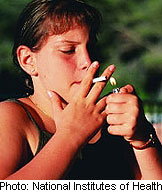
MONDAY, Feb. 18 (HealthDay News) — Young adults and teens who smoke, are obese and have high blood sugar levels may be more likely to die before they reach their 55th birthday, new government research suggests.
The findings are concerning when viewed in context of the rising rates of childhood obesity in the United States. Childhood obesity has more than doubled in children and tripled in adolescents in the past 30 years, according to the U.S. Centers of Disease Control and Prevention. As a result, diseases and conditions previously only seen in adults are increasingly being diagnosed in children. These include high blood pressure, high cholesterol and type 2 diabetes.
“Given the numbers of youth who are obese, this is a concern,” said the study’s author, Dr. Sharon Saydah, a CDC senior scientist. “Any time somebody dies before age 55, it has an overall societal impact.”
The average life expectancy in the United States is 78.7, according to the CDC.
The report was published online Feb. 18 and will be in the March print issue of the journal Pediatrics.
Saydah and her colleagues analyzed data on close to 9,250 people who took part in the third National Health and Nutrition Examination Survey.
Participants were aged 12 to 39 when the study was conducted. Of these, more than 15 percent were obese, and 30 percent were smokers. Overall, 298 of the participants died before they turned 55.
Those who smoked between the ages of 12 and 39 had an 86 percent greater risk of dying before 55, compared with those who did not, the data showed. Those who were obese when they were young had a 39 percent higher likelihood of dying before 55, compared with those not obese during these early years. In addition, the risk of dying before 55 tripled among those with high blood sugar levels between the ages of 12 to 39, the study showed. High blood pressure and high cholesterol levels, however, did not affect the risk of dying before age 55.
So, what can parents do today to help their kids live longer, healthier lives?
“There is not one specific thing we can recommend,” Saydah said. “There is a need for more effective strategies to try and prevent obesity and smoking, and improve the overall health of the younger population.”
This starts with encouraging healthier eating, a more active lifestyle and smoking cessation, she added.
Dr. Nazrat Mirza, an attending pediatrician in the Goldberg Center for Community Pediatric Health at Children’s National Medical Center in Washington, D.C., said the new study confirms other findings and does so using nationally representative data.
“It’s another wake-up call that obesity is associated with a higher risk of early death,” she said. And this risk starts to build early in life.
“The stakes are very high,” she added. “If these current trends continue, we won’t become extinct, but it will affect our workforce and our defense.”
Prevention is the key, Mirza said, adding, “Parents must set the stage very early in life by teaching and modeling healthy behaviors that will track into adolescence and early adulthood.”
One expert noted that, as a doctor, she planned to do more to get the message across to adolescents.
“The poignancy of the study is the fact that these risks affect us at an earlier age,” said Dr. Lisa Ipp, an assistant professor in pediatrics at Weill Cornell Medical College in New York City, who added she may turn the volume up on her usual healthy living messages as a result of these findings.
“Adolescents are a challenging group and we try our best to do risk reduction counseling and get them to get out of harm’s way,” she said. “But based on this data, we will certainly push a little bit harder.”
More information
Get the facts on childhood obesity and how to prevent it at the U.S. Centers for Disease Control and Prevention.

